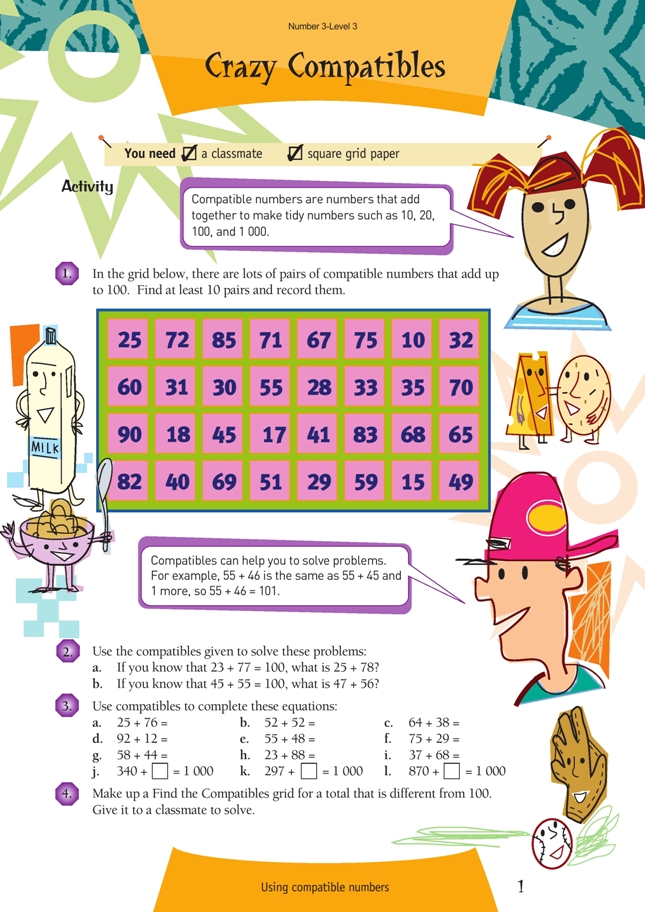This is a level 3 number activity from the Figure It Out series. It relates to Stage 6 of the Number Framework.
A PDF of the student activity is included.
Click on the image to enlarge it. Click again to close. Download PDF (145 KB)
use compatible numbers to solve addition problems
FIO, Level 3, Number, Book 3, Crazy Compatibles, page 1
A classmate
To do this activity, students need to know the basic addition and subtraction facts. Encourage your students to use the facts they know to derive the facts they don’t know. For example, 55 + 49 can be seen as 55 + 45 + 4 and 49 + 49 can be seen as 50 + 50 – 2.
Compatible numbers add together to make rounded or tidy numbers, such as 3 + 7 = 10, 30 + 70 = 100, and 300 + 400 = 700. Use examples such as these to ensure that the students see the connections between hundreds, tens, and ones. (See Number: Book One, Figure It Out, Level 2, page 6 for an activity that focuses on these connections.) The students can use these connections and tidy numbers to solve problems such as 25 + 76 = and 297 + = 1 000 in question 3.
After the students have done question 1, you could ask them: “What other type of problems can compatible numbers help you to solve mentally?” (Any that include numbers that have a tidy number total close by. For example, 47 is close to 50 and 31 is close to 30. So 47 – 31 could be seen as 50 – 30 – 4.)
Some students may find question 2 difficult because they cannot see the connections between the known and unknown facts. You could prompt them by drawing their attention to the example given in the boy’s speech bubble, which builds on one of the compatibles in question 1.
Question 3 builds on this understanding and extends it to 3-digit numbers. It also draws on the students’ understanding of place value.
In question 4, the students have to make their own compatible numbers grid, using numbers that add up to a total other than 100. The students’ grids will need to have an even number of squares, such as 3 by 4 or 4 by 4.
Further discussion and investigation
You could extend the idea of compatible numbers to fractions and decimals, provided that the students understand these concepts.
Answers to Activity
1. 10 of the following pairs:
25 + 75 = 100
75 + 25 = 100
72 + 28 = 100
28 + 72 = 100
85 + 15 = 100
15 + 85 = 100
71 + 29 = 100
29 + 71 = 100
67 + 33 = 100
33 + 67 = 100
10 + 90 = 100
90 + 10 = 100
32 + 68 = 100
68 + 32 = 100
60 + 40 = 100
40 + 60 = 100
31 + 69 = 100
69 + 31 = 100
30 + 70 = 100
70 + 30 = 100
55 + 45 = 100
45 + 55 = 100
35 + 65 = 100
65 + 35 = 100
18 + 82 = 100
82 + 18 = 100
17 + 83 = 100
83 + 17 = 100
41 + 59 = 100
59 + 41 = 100
51 + 49 = 100
49 + 51 = 100
2. a. 103. (23 + 2 + 77 + 1 = 103)
b. 103. (45 + 2 + 55 + 1 = 103)
3. a. 101
b. 104
c. 102
d. 104
e. 103
f. 104
g. 102
h. 111
i. 105
j. 660. (340 + 60 = 400. 400 + 600 = 1 000. 60 + 600 = 660)
k. 703. (297 + 3 = 300. 300 + 700 = 1 000. 3 + 700 = 703)
l. 130. (870 + 30 = 900. 900 + 100 = 1 000. 30 + 100 = 130)
4. Practical activity
